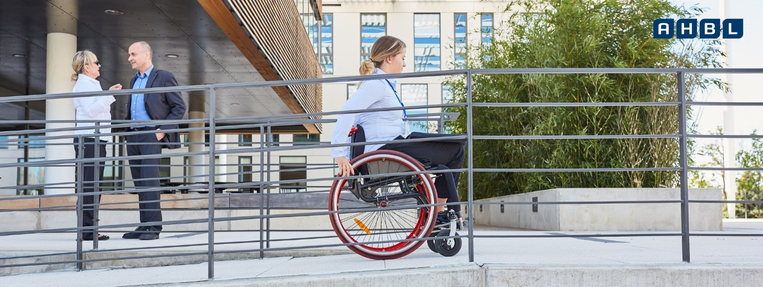Embracing Inclusivity in Design
Beyond the Bounds of ADA Standards
Author: Meiing Sproger
Contributor: Karen Braitmayer, FAIA
As an engineer or architect, it is crucial to have a thorough understanding of the Americans with Disabilities Act (ADA) and the standards that designs must follow to ensure accessibility. AHBL had the opportunity sit down with Karen Braitmayer, FAIA, founder and managing principal at Studio Pacifica in Seattle, Washington to learn her philosophy regarding the integration of ADA requirements into design.
With a deep-rooted belief that accessibility is integral to exceptional design, Braitmayer shares her personal experiences and invaluable insights. Together, we dive into the topic of integrating accessibility from the inception of a design, embracing diverse abilities, and the continuous learning process necessary to foster truly inclusive spaces.
Can you describe your experience creating designs that comply with the ADA and share a recent innovative accessibility solution you have developed?
“As a lifelong wheelchair user, I've always seen the world from a “elevators are good, stairs are not so good” perspective. Therefore, when I think about how to create a space, I'm intentional to make it a place where my friends, family, and I can all access and enjoy.
As an example. there’s a movement towards using destination dispatch elevator in high rise buildings. This system makes vertical circulation more efficient. However, the flat screen on the call panel might be hard for the low vision and blindness community and those with mobility or dexterity limitations. To address the dexterity component of this accessibility issue, we advocated for the addition of an additional call actuator button compatible with an individual’s mobility device to scroll through the panel.”
Can you describe a recent project that involved going beyond the ADA standards?
“Every project we work on incorporates state and federal codes and standards. But in terms of how best practices might influence a design, well, we try to think about how people will interact with our designs and try to give them choices with how they engage with a building. A successful inclusive project is one you can’t really see it, where inclusion is just integrated.
For instance, imagine you arrive at an office building for a meeting. You come to the front door, a power door actuator is available to open the door, and you flow into the reception. There you are greeted by a low/high receptionist desk. There are also multiple seating options available for people with different physical abilities in the waiting space. You don’t ever feel obstructed throughout the process of going to your meeting. That is great design.”
How do you stay up to date with the latest ADA regulations?
“I learn a lot from peers in the accessibility consulting community as well as architects and contractors who are trying to figure out how implement the standards and codes, and successfully build their projects. Additionally, I lean on conversations with the disabled community and their advocates to develop design solutions. By asking questions like, What are your challenges? Where are you struggling? How can we make this easier? I am able to create solutions for them.
In July, the state of Washington will be adopting the 2021 IBC with 2017 AII7 and that will come with significant code changes; changes that the disability community have wanted for a long time. For instance, there will be a new requirement for additional clear floor space for wheelchair users in new construction.
A peak into the future, and we are also expecting a code update that will require adult sized changing stations in high traffic areas such as airports, stadiums, and shopping malls. This movement has been a very well received and it is encouraging to see companies and government give their support.”
How do you incorporate user feedback into your design process?
“We prioritize community outreach and engagement to ensure we gather feedback from a diverse range of perspectives. We have a built-in feedback loop for public projects such as working with individuals that are interested in Diversity, Equity, and Inclusion (DEI) issues and are willing to share their ideas.
People with disabilities have valuable insights and problem-solving abilities, as they have experience in creating hacks to make things work for their needs. By organizing accessible outreach events, we can receive feedback on the accessibility of our projects. We make efforts to reach out in different languages and provide information in advance for those who need it. Additionally, we recommend offering materials in large print, braille and provide tactile models for a better understanding. We recognize that PowerPoint presentations are not accessible for all participants, so we explore alternative means of communication.”
Designing with ADA and inclusivity in mind is essential for architects and engineers. Through the process of developing innovative solutions to challenges, incorporating user feedback, and ongoing education, we can create designs that meet legal requirements while fostering a more inclusive and welcoming society.
